|
|
|

Merry Christmas & Happy New Year 2014

Music arranged / played by Mark Schumacher. Song by Pepe.
|
|
|
  A Kick-Start Card from Keiko and Mark Schumacher A Kick-Start Card from Keiko and Mark Schumacher
|
|
|
|
|
|
THE HORSE IN JAPANESE TRADITIONS
|
|
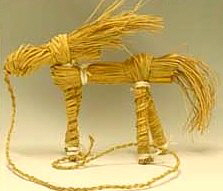
|
Mukae Uma 迎馬, Welcoming Horse
Votive horses shaped from straw & straw-like reeds are made in 39 prefectures of Japan. They are made to transport the souls of the ancestors back to the family during Obon. They also serve as transportation for the deities to attend festivals. These mini horses are also offered to the gods as a thank-you present when livestock is well. As talismans, they help ward off evil. <More Photos>
|
|
|
THE HORSE, PARTICULARILY THE WHITE HORSE, is a sacred animal in Japanese Shintō traditions. Local deities (kami) are believed to ride horses between this world and the sacred realm, and hence the horse represents the connection between earth and heaven. In olden times, the ruling elite would present real horses to Shintō shrines when making a vow or entreaty, for the animal was considered an auspicious messenger of the gods. The text Shoku Nihongi (compiled in 797 AD) mentions that white horses were dedicated to shrines when praying for rain to end, while black horses were presented when praying for rain to fall. The white horse is considered the sacred mount of Amaterasu (Japan's supreme sun goddess) and even today various shrines dedicated to Amaterasu keep a white horse in their stables. White is the color of purity and as such is treasured by Shintō. There is also the belief that fine horses are the offspring of dragons and other water gods. The tradition of offering real horses to Shintō shrines was beyond the means of most people, but over the centuries, small wooden horse statues and pictorial votive tablets known as EMA 絵馬 (lit. "horse pictures") were presented as substitutes for the real animal. Today, during the annual Tanabata festival on July 7, a small welcoming horse (mukae-uma 迎馬) is hung from gates and trees to be offered as a mount for the visiting deity. Horse effigies are also offered to ancestral spirits during the Obon festival. See photo at left.
 |
|
KOMAGATA SHRINES 駒形神社
Lit. = Horse-Shaped Shrines
Found throughout Japan, Komagata shrines are devoted to the local kami (gods and goddesses) of horses, including 宇迦之御魂神 (Ukanomitama no mikoto), 天照大神 (Amaterasu Ōmikami), 天忍穂耳尊 (Ame no oshihomimi), 天之常立神 (Amenotokotachinokami), and numerous other folk deities serving as protectors of horses. Batō Kannon (the Horse-Headed Kannon) is identified as the Buddhist counterpart of the Komagata deities. Iwate was one of Japan's most famous horse-breeding centers in olden days, and the Komagata Shrine in Iwate Pref. is thus befittingly one of Japan's most well-known.
|
|
|
|
|
|
JAPANESE VOTIVE TABLETS OF THE HORSE
Known as EMA 絵馬 (literally "HORSE PICTURES"), votive tablets can be purchased at most shrines and temples for around $10 or less. You write your name and petition on the back, and then hang the tablet inside the compound in the hope the kami (deity) will answer your prayer. Says JAANUS: "Ema 絵馬. Lit. horse painting. Illustrated wooden plaques given as votive offerings to shrines and temples. It is believed that the custom of donating ema has its roots in the ancient practice of presenting a sacred white horse (shinme or jinme 神馬) to a shrine for use in rituals and as an auspicious symbolic messenger of the gods. Later, small wooden statues of these sacred horses were presented as substitutes. These statues were then simplified to images of a horse carved in relief, usually on a wooden plaque. By the late Edo period (18th century), paintings on ema came to depict not only the sacred horse but also a great variety of other subjects."
|
|
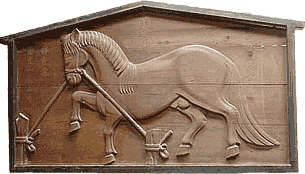
Votive Horse Tablet
Wood Carving, Dated 1646, W = Approx. 100 cm
Hase Dera Temple 長谷寺, Kamakura
|
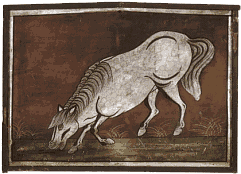
Votive Horse Tablet
Painting on Wood, Dated to 18th century
Japan Folk Crafts Museum (Mingeikan)
|
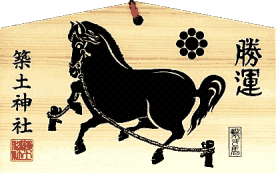
Votive Horse Tablet, H = 9 cm, W = 14 cm
Tsukudo Jinja 築土神社, Tokyo.
This shrine is dedicated to samurai Masakado.
|
|
|
|
|
|
|
|
|
|
HORSE IN JAPANESE ART AND RELIGIOUS LORE
The horse is connected to numerous people, deities and legends in Japan. Prince Shōtoku Taishi (574 - 622 AD), for example, the first great patron of Buddhism in Japan, was born in front of a horse stable -- hence the Prince is also known by the names Umayado 厩戸皇子 or Umayado no Ōji 厩戸皇子王子 (lit. Prince of the Stable Door). When the prince was born, Bodhidharma (Daruma, the father of Zen Buddhism) supposedly manifested himself as a horse and neighed three times.
|
|
Amaterasu and White Horse
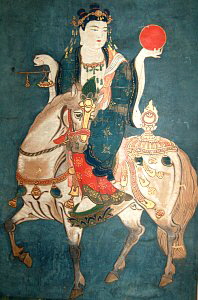
Amaterasu atop White Horse. Muromachi Era. Private collection. The white horse is considered sacred in Shintō and especially associated with Amaterasu, the supreme sun goddess. Japan's imperial family claims direct descent from her lineage. In artwork Amaterasu may manifest as the horse itself or sometimes, as shown here, she is portrayed riding the beast. Ise Shrine, the most important bastion of Amaterasu belief, even today stables a white horse on its precincts. The white horse is considered Amaterasu's preferred means of transportation, and thus the animal represents the connection between earth and heaven. More details.
|
Horse-Headed Kannon
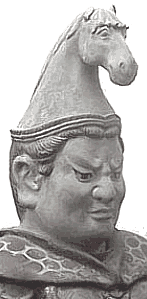
Horse-Headed Kannon (Batō Kannon). 15th century, Hase Dera, Kamakura. Japanese farmers pray to Batō for the safety and preservation of their horses and livestock. Batō protects animals, particularly those who labor for mankind, but extends those powers to those reborn in the animal realm -- one of the six realms of karmic rebirth. Batō is especially honored by horse breeders in northern Japan. Numerous steles of Batō from the Edo era are extant and dedicated to a deceased horse (as attested by the inscription uma kuyō 馬供養). Also, many extant stone statues of Batō were erected to protect travelers and their horses from injury on dangerous paths. In Buddhist traditions from the mainland, the horse is a symbol of dominion of the "Ideal King" (Jp. = Kyōryōjō-ō 教令聖王, Skt. = Chakravartin). More details.
|
Horses, Monkeys, and Foxes
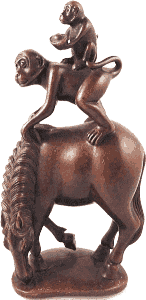
Monkey Atop Horse. Edo era. In China and Japan, the monkey is often shown riding a horse. This symbolism stems from the 16th-century Chinese story Journey to the West, in which the Jade Emperor appoints the Monkey to the post of "Protector of Horses" to pacify the monkey's desire for power and recognition. Elsewhere, the horse is also closely connected to Inari (Shintō kami of rice), whose holy day or ennichi is the Day of the Horse. Based on tradition, Inari descends from his winter mountain retreat to the rice paddy in spring, during the planting season. He rides atop a horse led by a fox. The fox is Inari's messenger. More details.
|
|
|
|
|
|
|
|
|
|
|
|
|